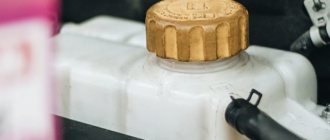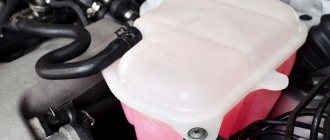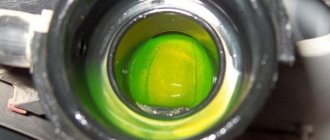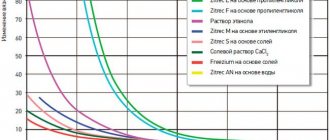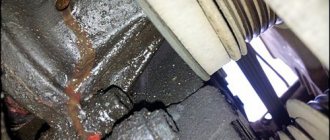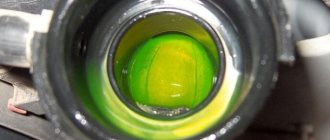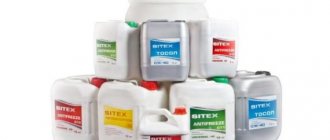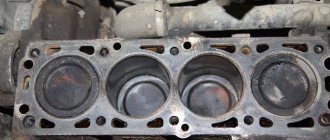01.03.2022 8 085 Coolant
Author: Victor
The purpose of the refrigerant is to provide high-quality cooling of the machine’s power unit and prevent it from overheating. If the system uses fluid that does not meet engine specifications, it will cause serious problems. We will tell you below how to find out whether antifreeze or antifreeze has been filled, and why the driver needs it.
[Hide]
Origins of the problem
As we already said, car owners usually know what they put into the cooling system. But there are times when the driver does not have reliable information. The following typical situations can be distinguished:
- The used car was recently purchased, but the buyer forgot to ask the former owner about what consumables were used.
- The car was received at work for long-term use. The previous employee could simply quit and not talk about how he serviced the vehicle.
- The driver notices that the cooling system is not working correctly. In this case, you can suspect that the wrong coolant was filled in at the car service center, but this needs to be checked somehow.
Why do you need to know this?
Finding out what is filled, Antifreeze or antifreeze, is useful for several reasons:
- The car was recently purchased second hand. It is logical to find out from the previous car owner what is used in the cooling system and when the consumables were last changed. This will allow you to find out when to make a replacement.
- There has been a malfunction in the cooling system. The heating device has become worse and sometimes the power unit overheats. Such problems are often caused by the use of low-quality refrigerant. It is useful to find out what exactly is in the system so that you never use such a product again.
- Even if everything works fine and there is no engine overheating, the car owner still needs to know what is used in the cooling system. At a minimum, so that if there is a shortage of refrigerant volume, you can understand what liquid to buy to add.
Differences in chemical composition
It must be said right away that any antifreeze and antifreeze are special automotive coolants. Only the last option is considered an exclusively domestic development, the roots of mass use of which go back several decades. In the Soviet era, only antifreeze was available to motorists. At this time, the question of how to determine what kind of antifreeze was poured into the car simply did not arise.
Relevance of the issue
Recently, a large number of modern coolant options have begun to appear on the market. Moreover, a clear division into antifreeze and antifreeze appeared. Some people believe that the difference is only in color, but this is not entirely true. In fact, the color of the coolant is not regulated by regulations. Therefore, the choice of colors depends only on the preferences of the manufacturers. For example, original VAG antifreezes are turquoise. And the blue color of antifreeze can be considered a tribute to tradition.
Real differences between antifreeze and antifreeze
Domestic coolant and its modern “competitors” differ primarily in their chemical composition. It is he who determines their operational characteristics. Antifreeze contains distilled water, ethylene glycol and a special mixture of inorganic acids. Silicates, nitrates, nitrites and phosphates are used as additives.
What does antifreeze consist of?
The base is distilled water, ethylene glycol and additives. It is in the additives that the main difference between the compositions lies. Only organic derivatives are used here. Additives provide anti-foam and anti-corrosion properties of the coolant.
Only recommended
Automobile concerns set a task for antifreeze manufacturers: for example, it is mandatory to get rid of environmentally harmful elements (amines, borates) in the coolant, and also, if possible, use glycerin from cheap biofuel production waste in the final product. The supplier fulfills the requirements, but the customer does not need to know the exact chemical formula. That’s why car manufacturers do not recommend other coolants for their cars. After all, for this you need to carry out compatibility tests, and this is a large-scale work: you need to mix products in different proportions, test each mixture in heat and cold, assess the presence of separation and precipitation. Therefore, automakers indicate which fluid completely suits them, and only recommends it to dealers.
Why don’t they at least specify the type of coolant - carboxylate, lobrid? For the same reason! The consumer must understand that any deviation from the factory recommendations may harm the vehicle. And taking advantage of the fact that the division of coolant into types is conditional, many automakers prefer to enter their own codes and codes. For example, in the Volkswagen classification, traditional coolants are designated as G11 (VW TL 774‑C), carboxylate coolants are designated as G12+ (VW TL 774‑F). Every manufacturer has similar specifications, but Volkswagen’s has taken root better than others in Russia, and many rely on it.
| Brand | Automaker recommendations |
| BMW | Only recommended coolants with anti-corrosion properties. From 04/01/2020 the new BMW specification applies to them "BMW Lifetime Coolant xx" , or |
| Brilliance | The coolant is of a traditional type, there are no recommendations for brands. Antifreeze G11 is used for Brilliance V3 |
| Changan | First fill - BASF G30 , there are no brand recommendations for dealers |
| Chery | Long-term antifreeze Liqui Moly G12+ |
| Hyundai | On use A-110 - phosphate lobride antifreeze . This product is specifically designed to meet Hyundai technical requirements and is officially approved by Hyundai |
| Kia | Lobrid coolant specifications Hyundai MS 591–08 |
| Mitsubishi | coolant Mitsubishi Motors Genuine Super Long Life Coolant Premium or its equivalent. The equivalent must be a high-quality ethylene glycol-based coolant that is free of silicates, amines, nitrates and borates and produced using hybrid organic-acid technology |
| Nissan | coolant Nissan L255N . Manufacturer - CCI manufacturing Germany GmbH (Germany), supplier - RTECO NV (Belgium) |
| Porsche | Lobrid coolant Glysantin G40 or alternative according to G12++/VW TL 774-G |
| P.S.A. (except Fiat, Mitsubishi, Toyota models) | Lobrid coolant based on concentrate Arteco Freecor DSC . |
| Renault | Coolant Glaceol type D |
| Skoda | Liquids are now used in Skoda cars G13 (propylene glycol) and G12 evo (lobrid). |
| Subaru | Amine-free, ethylene glycol-based coolant |
| Toyota | Toyota Super Long Life Coolant , hybrid technology |
| Volvo | Branded coolant Volvo . There are no recommendations for other brands. Swedish specialists and suppliers do not use the terms “lobrid” and “hybrid”. The coolant is based on salts of organic acids, phosphates, and silicates. Free from nitrites, amines and borates |
| VW | Since 2008 - G12++ . |
| VAZ | Since 2010, carboxylate type coolants have been used. For the first refueling, two types of liquids that differ in color are used (and recommended for use). You can't mix them. For Lada Granta (Kalina), Vesta (with engines models 21129 and 21179) and Lada 4x4 - red coolant: SinteC antifreeze (JSC Obninskorgsintez) TU 2422-047-51140047; For Lada Largus, XRAY and Vesta cars (with H4 engine) - yellow-green coolant: Cool Stream NRC (JSC Technoform) TU 2422-001-13331543 (concentrate) |
And now - some general recommendations.
How different coolants work
Features of antifreeze
The formula of the domestic composition works in such a way that a thin protective film is formed on all surfaces of the cooling system. It not only helps fight corrosion processes, but also significantly reduces heat transfer. Due to an increase in engine temperature, fuel consumption increases, and the life of the power unit also suffers. It should also be noted that the silicates and phosphates that make up the refrigerant over time form an insoluble precipitate that settles on the internal walls of the lines and radiator, which reduces the cooling efficiency and leads to the inevitable replacement of parts. And antifreeze loses its properties after 30–40 thousand kilometers.
Features of antifreeze
The composition includes special anti-corrosion additives that form a protective oxide layer only in those places that have already begun to oxidize. Therefore, antifreeze does not reduce the efficiency of the cooling system. Standard trains are designed for 100–150 thousand km. If you buy high-quality antifreeze, then deposits will not accumulate on the inner walls.
How to determine what is flooded in practice
When we have already studied the chemical and operational features of antifreeze and modern antifreeze, it’s time to figure out how to distinguish them. Let us remind you right away that you cannot rely on the color of the liquid. While antifreeze is almost always blue in color, antifreeze manufacturers use a variety of dyes, including blue ones. And of course, you cannot use taste buds to determine the type of coolant. Yes, there are rumors that antifreeze is a little sweet, but we strongly do not recommend checking this, because coolants contain toxic substances that, even in small dosages, can seriously harm your health.
I have red antifreeze - do you have red?
Antifreezes, which are used by automakers for filling at the factory, are liquids consisting of 4 components:
- demineralized water
- ethylene glycol (in Volkswagen cars can be replaced by glycerin, but not more than 20%)
- a package of additives that stops severe corrosion of metals and corrosion of polymers of the cooling system from ethylene glycol
- dye
The first 3 components are transparent. The dye is added so that antifreeze from different manufacturers differs in some way in appearance, except for the label and the color of the canister (many brands even use the same canister - for example, Volvo, Land Rover, Motul).
When choosing antifreeze, you cannot focus on color. You only need to look at the tolerance of antifreeze, by analogy with oils. Therefore, either the original or a rebrand of the original.
Methods for determining coolant type
There are safer and more accurate ways to understand what kind of coolant is in your car. Let's look at the most popular methods:
- Smell and tactile sensations . High-quality antifreeze is practically devoid of aroma, and it feels very oily to the touch. Domestic refrigerant has a characteristic chemical odor, and its lubricating qualities are not so obvious.
- Mixing with water . You can try making a solution of water and coolant in a 1:1 ratio. When preparing it, the composition must be thoroughly mixed and left at rest. If after a few hours the contents began to become cloudy or separate into fractions with different densities, then antifreeze was poured into the car. High-quality antifreeze mixes well with water in any proportion.
- Density measurement . This is perhaps the most accurate method for determining the type of coolant. But for its practical use you will need an aerometer - an inexpensive device for measuring the density of a liquid. Measurements must be taken at room temperature. If the readings range from 1.073 to 1.079 g/cm³, then this is a good antifreeze. High-quality antifreeze always has a lower density, since its standard value is 1.065 g/cm³.
Folk way to determine coolant
Experienced craftsmen often use the following technique to distinguish antifreeze from antifreeze. To check, you will need any steel part with pockets of corrosion and some rubber (for example, you can use a section of a cooling system pipe). These products should be placed in a container with coolant for a short time. Domestic antifreeze will form a protective film on all surfaces. Modern antifreeze has a more “smart” formula, since the composition leaves an oxide film only on metal that has been subjected to corrosion processes. Therefore, if after removal the rubber has a slippery coating and the steel part is completely covered with a film, antifreeze was used in the experiment. If only the spots of rust on the metal changed color, and the surface of the rubber did not change its qualities, then there was high-quality antifreeze in the container.
How to be 100% sure
All the described methods for distinguishing antifreeze from antifreeze are quite accurate, but they still do not provide a complete guarantee. For example, you can never exclude the risk of purchasing a low-quality composition that simply does not exhibit characteristic qualities. In order not to risk the health of the engine, experienced drivers recommend playing it safe. If you start using your car, but do not know what kind of refrigerant circulates through the cooling system, then it is better to replace it with a composition that is known to be of high quality. You should first flush the lines and radiator using special compounds or distilled water. You will spend a small amount of money on this, but you will get 100% confidence that the car is being used correctly.
Let's sum it up
Now you know how to understand what kind of coolant is in your car and why it is important. Remember that 100% conclusions can only be drawn after a laboratory examination. But in practice, it is easier to replace an unknown coolant with a new composition purchased in a reliable place.
#Advice from experts
You may also be interested
Is it possible to mix G11 and G12 antifreezes?
When switching from one antifreeze to another, the ideal option would be to completely drain the old one, flush the cooling system and fill in the new one. However, it is not always possible to do this. Therefore, for many drivers the relevant question is: how safe will it be to mix different coolants?
How to properly pour antifreeze into the system
The composition of antifreeze may vary from brand to brand, so the car owner may have a number of questions before adding it. What product can be used, how to add liquid correctly, what is the algorithm of action - all this determines how successful the refill will be.
What else should you pay attention to?
One of the most important characteristics of antifreeze is temperature. The temperature at which antifreeze begins to crystallize is –40 °C. Once it is reached, the first signs of freezing appear. This temperature indicates the lower threshold for antifreeze use. At a temperature of complete freezing (–43 °C), the antifreeze completely turns into a gel.
The boiling point of the liquid at atmospheric pressure should be at least 108 °C, preferably 110 °C (modern engines are becoming increasingly “hot” - temperature-stressed). Most often, in a closed cooling system, the pressure is higher than atmospheric, so there is another reference characteristic: the boiling point at a pressure in the system of 2 atmospheres. There are different values: from 123 to 129 °C.
When purchasing antifreeze from an independent manufacturer, you need to make sure that the liquid will withstand the service life established by the technical regulations. Carboxylate antifreezes have a long service life - 5 years or 250,000 km. It happens that there is no expiration date on the antifreeze package at all. Or on the front label there is the inscription G12+, and on the back label a period of 2 or 3 years is indicated. In this case, there is no need to waste time finding out what the service life of the product is or why Long Life antifreeze only lasts 2 years - it’s easier to choose something else.
